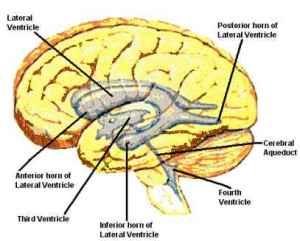

MedFriendly®


Posterior Horn of the Spine and Brain
There are two areas known as the posterior horn in the
human body. One is an area of the brain located in the
posterior/occipital (back) part of the lateral ventricles.
The lateral ventricles are two curved openings (shaped
like a horseshoe) located deep within the top section of
the brain that provides a pathway for cerebrospinal fluid.
Cerebrospinal fluid is the cushiony fluid that protects the
brain and spine from trauma. The 2nd and 6th layers of
the posterior horn release powerful pleasure causing
chemicals known as enkephalin and dynorphin. The
other area known as the posterior horn is located in the
spinal cord. This is a horn-shaped area of gray matter
(tissue) in the back of the spine that receives different
types of sensory information such as vibration sense,
light touch, and proprioception.
The posterior horn of the lateral
ventricles in the brain. Other
ventricles are also pictured.
FEATURED BOOK: Neuroanatomy through Clinical Cases
Proprioception is the ability to sense or perceive the spatial position and movements of
the body and the strength of effort that is needed in movement. The posterior horn
receives the sensory information from receptors of the bones, joints, and skin through
sensory nerve cells whose cell bodies are located in the dorsal root ganglion, which is a
bumpy area on a type of spinal nerve that sends sensory information to the spine. The
posterior horn is divided into four layers known as laminae. Lamina I is known as the
marginal lamina. Lamina II is known as the substantia gelatinosa. Layers III and IV are in
a laminar area known as the nucleus proprius.
"Where Medical Information is Easy to Understand"™
The posterior horn is also known as the cornu posterius ventriculi lateralis (in English that means the
posterior horn of the lateral ventricle), cornu posterius, cornua of the spinal corn, and the occipital horn.
Posterior horn comes from the Latin word "posterior" meaning "behind," and from the Proto-Indo-European
word “ker” meaning “uppermost part.” Put the words together and you have “behind (the) uppermost part.”















